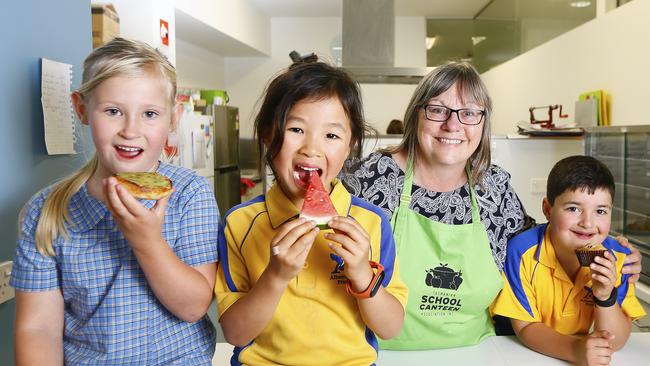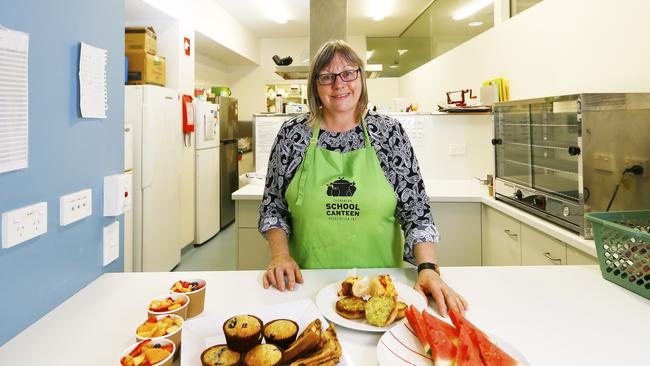Tasmania should lead way in school canteen revolution, say food experts
Tasmania’s small size and access to fresh quality produce is fuelling hopes the state could lead the nation in adopting a new approach to healthy school lunches.

Tasmania
Don't miss out on the headlines from Tasmania. Followed categories will be added to My News.
A TASMANIAN health educator hopes to revolutionise the state’s school lunches after gaining a Churchill Fellowship to investigate the healthy habits of other cultures.
Tasmanian School Canteen Association executive officer Julie Dunbabin will investigate all aspects of school lunches — from the menus to the time allocated to eating — in Japan, Europe and the US.
Mrs Dunbabin said she believed Tasmania’s small size and access to fresh, quality produce meant the state could lead the nation in a new approach to school lunches.
“It’s about making food an important part of the whole education process, because if you are fed well you can reach your best potential,” she said.
Pressure is mounting on schools to adopt healthy canteen menus, to meet a State Government target of having all schools working towards healthy menus by 2020.
It’s about making food an important part of the whole education process, because if you are fed well you can reach your best potential
So far 110 government schools are on board with the Tasmanian School Canteen Association’s healthy standards, but there are still 60 that need to start the process.
Mrs Dunbabin said other countries took a very different approach to Australia’s rushed approach to school lunches, with many countries in Europe supplying cooked, three-course meals and children allocated a longer time to eat.
She said adopting nutritionally balanced sit-down meals at lunch time could see improvements in educational outcomes as well as better health outcomes.
“I want to gather information about how and why other countries do what they do, and whether it’s possible for Tasmania to do the same,” she said.
“With our great food movement, we could lead the way. And our size means changing culture would be easier here than on the mainland.”

Mrs Dunbabin also hopes to meet former US first lady Michelle Obama, who spearheaded the Healthy, Hunger-Free Kids Act, which authorised funding for healthy school lunch programs.
“Michelle Obama has a real passion in this area and the role of the food industry in children’s health,” Mrs Dunbabin said.
The newly announced 2018 Churchill Fellow went to primary school in the UK system, where schools have traditional sit-down meals at lunch.
As well as travelling to the UK, Mrs Dunbabin will investigate the culture in France, where lunch times are long.
“I want to look at why the French Government pays for every child’s school lunch, no matter what school,” she said.
“They have small three-course lunches, with a balanced portion of protein, grains, vegetables, fruit and dairy.
“And they all sit down and they allocate two hours for lunch time. It creates a totally different structure to the school day.”
She said Japan had a completely different approach, by involving children in the preparation and cooking of food, as well as the cleaning up.
They all sit down and they allocate two hours for lunch time. It creates a totally different structure to the school day
Mrs Dunbabin, who will leave for her Churchill Fellowship studies next September, said great work was already being done in Tasmania at reducing junk food in schools — as shown by the growing number gaining accreditation with the Tasmanian School Canteen Association.
There are now 72 government and non-government schools with accreditation, which is a sharp rise on the 23 schools accredited in 2010.
Of those accredited schools, 45 have achieved gold-standard accreditation, 21 have silver and six have bronze. There are another 68 schools working towards becoming accredited with the TSCA.
The State Government has set a target that all government schools are to have commenced a process to achieve canteen accreditation by no later than 2020.
“We currently have 110 of the 170 government schools with a canteen on board — 60 accredited and 50 working toward accreditation,” Mrs Dunbabin said.
She said there had been a jump in high schools becoming accredited for the first time.
anne.mather@news.com.au


